Related Research Articles

Drag racing is a type of motor racing in which automobiles or motorcycles compete, usually two at a time, to be first to cross a set finish line. The race follows a short, straight course from a standing start over a measured distance, most commonly 1⁄4 mi, with a shorter, 1,000 ft distance becoming increasingly popular, as it has become the standard for Top Fuel dragsters and Funny Cars, where some major bracket races and other sanctioning bodies have adopted it as the standard. The 1⁄8 mi is also popular in some circles. Electronic timing and speed sensing systems have been used to record race results since the 1960s.
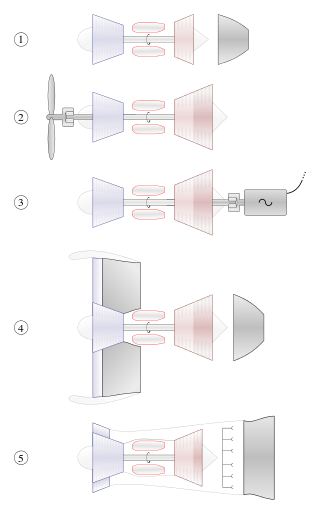
A gas turbine, also called a combustion turbine, is a type of continuous flow internal combustion engine. The main parts common to all gas turbine engines form the power-producing part and are, in the direction of flow:

The National Hot Rod Association (NHRA) is a drag racing governing body, which sets rules in drag racing and hosts events all over the United States and Canada. With over 40,000 drivers in its rosters, the NHRA claims to be the largest motorsports sanctioning body in the world.

Donald Glenn Garlits is an American race car driver and automotive engineer. Considered the father of drag racing, he is known as "Big Daddy" to drag racing fans around the world. A pioneer in the field of drag racing, he perfected the rear-engine Top Fuel dragster, an innovation motivated by the loss of part of his foot in a dragster accident. This design was notably safer since it put most of the fuel processing and rotating parts of the dragster behind the driver. The driver was placed in front of nearly all the mechanical components, thus protecting him and allowing him to activate a variety of safety equipment in the event of catastrophic mechanical failure or a fire. Garlits was an early promoter of the full-body, fire-resistant Nomex driving suit, complete with socks, gloves, and balaclava.

Funny Car is a type of drag racing vehicle and a specific racing class in organized drag racing. Funny cars are characterized by having tilt-up fiberglass or carbon fiber automotive bodies over a custom-fabricated chassis, giving them an appearance vaguely approximating manufacturers' showroom models. They also have the engine placed in front of the driver, as opposed to dragsters, which place it behind the driver.

Top Fuel is a type of drag racing whose dragsters are the quickest accelerating racing cars in the world and the fastest sanctioned category of drag racing, with the fastest competitors reaching speeds of 335 miles per hour (539.1 km/h) and finishing the 1,000 foot (304.8 m) runs in 3.62 seconds.

A business jet, private jet, or bizjet is a jet aircraft designed for transporting small groups of people. Business jets may be adapted for other roles, such as the evacuation of casualties or express parcel deliveries, and some are used by public bodies, government officials or the armed forces.

The Ford FE engine is a Ford V8 engine used in vehicles sold in the North American market between 1958 and 1976. The FE was introduced to replace the short-lived Ford Y-block engine, which American cars and trucks were outgrowing. It was designed with room to be significantly expanded, and manufactured both as a top-oiler and side-oiler, and in displacements between 332 cu in (5.4 L) and 428 cu in (7.0 L).

The Fiat Punto is a supermini car (B-segment) produced by the Italian manufacturer Fiat from 1993 to 2018, spanning over three generations. The third generation of the car was marketed between 2005 and 2009 as the Grande Punto, and between 2009 and 2012 as the Punto Evo, when the single-word Punto name was reintroduced. As of May 2013, nearly nine million units had been sold globally.

The Rolls-Royce Avon was the first axial flow jet engine designed and produced by Rolls-Royce. Introduced in 1950, the engine went on to become one of their most successful post-World War II engine designs. It was used in a wide variety of aircraft, both military and civilian, as well as versions for stationary and maritime power.
Walter Charles Arfons was the half brother of Art Arfons, his former partner in drag racing, and his competitor in jet-powered land speed record racing. Along with Art, he was a pioneer in the use of aircraft jet engines for these types of competition.

Top Alcohol refers to two different classes in professional drag racing: Top Alcohol Dragster and the Top Alcohol Funny Car. Commonly known as "alky" cars, both are akin in design to the premier Top Fuel classes, but less powerful. In both classes, the cars are either supercharged ("blown") engines, burning alcohol (methanol) or can burn nitromethane and be normally aspirated, fuel injected engines. Top Alcohol Dragsters and Funny Cars resemble their nitromethane (Fuel) counterparts, with about half the power of their respective classes. Each car uses a three-speed transmission.

The Fiat Linea is a compact sedan released on 26 March 2007 at the Tofaş plant in Bursa, Turkey, by the Italian automaker Fiat as a world car in developing countries. It is based on the current Fiat Grande Punto platform. The Linea was designed by Fiat Style Centre and co-developed by Tofaş and Fiat do Brasil. Production in Turkey ended in 2016.
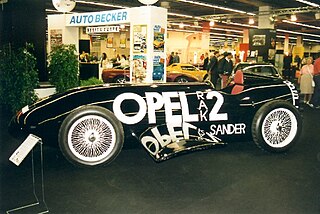
A rocket car is a land vehicle propelled by a rocket engine. A rocket dragster is a rocket car used for competing in drag racing, and this type holds the unofficial world record for the 1/4 mile.
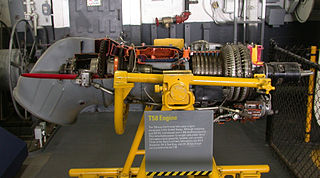
The General Electric T58 is an American turboshaft engine developed for helicopter use. First run in 1955, it remained in production until 1984, by which time some 6,300 units had been built. On July 1, 1959, it became the first turbine engine to gain FAA certification for civil helicopter use. The engine was license-built and further developed by de Havilland in the UK as the Gnome, in the West Germany by Klöckner-Humboldt-Deutz, and also manufactured by Alfa Romeo and the IHI Corporation.

A V8 engine is an eight-cylinder piston engine in which two banks of four cylinders share a common crankshaft and are arranged in a V configuration.

The Westinghouse J46 is an afterburning turbojet engine developed by the Westinghouse Aviation Gas Turbine Division for the United States Navy in the 1950s. It was primarily employed in powering the Convair F2Y Sea Dart and Vought F7U Cutlass. The engine also powered the land speed-record car known as the Wingfoot Express, designed by Walt Arfons and Tom Green It was intended to power the F3D-3, an improved, swept-wing variant of the Douglas F3D Skyknight, although this airframe was never built.
Electric drag racing rules are very different from traditional drag racing. The common safety rules apply but additional rules apply depending on voltage, battery type, motor number and configuration. The National Electric Drag Racing Association (NEDRA) oversees the majority of electric drag racing events in North America.
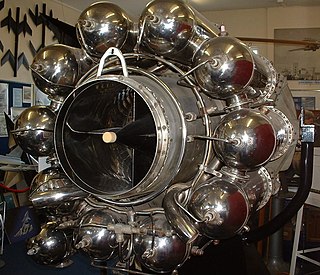
The Power Jets W.2 was a British turbojet engine designed by Frank Whittle and Power Jets Ltd. Like the earlier Power Jets W.1, the reverse-flow combustion configuration included a double-sided centrifugal compressor, 10 combustion chambers and an axial-flow turbine with air-cooled disc.
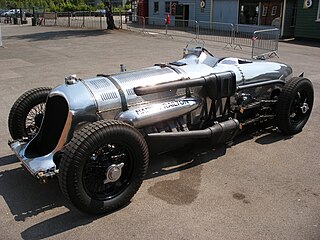
An aero-engined car is an automobile powered by an engine designed for aircraft use. Most such cars have been built for racing, and many have attempted to set world land speed records. While the practice of fitting cars with aircraft engines predates World War I by a few years, it was most popular in the interwar period between the world wars when military-surplus aircraft engines were readily available and used to power numerous high-performance racing cars. Initially powered by piston aircraft engines, a number of post-World War II aero-engined cars have been powered by aviation turbine and jet engines instead. Piston-engined, turbine-engined, and jet-engined cars have all set world land speed records. There have also been some non-racing automotive applications for aircraft engines, including production vehicles such as the Tucker 48 and prototypes such as the Chrysler Turbine Car, Fiat Turbina, and General Motors Firebirds. In the late 20th century and into the 21st century, there has also been a revival of interest in piston-powered aero-engined racing cars.
References
- ↑ "FireForce 1 – FireForce". www.fireforce.co.uk.
- ↑ "FireForce 2 – FireForce". www.fireforce.co.uk.
- ↑ "FireForce 3 – FireForce". www.fireforce.co.uk.
- ↑ "FireForce 4 – FireForce". www.fireforce.co.uk.
- ↑ "FireForce – The fastest Jet Funny Jet Car In the world". www.fireforce.co.uk.
- ↑ "FireForce 5 – FireForce". www.fireforce.co.uk.
- ↑ "FireForce 3 Jet Car | Classic Ford Show". www.classicfordshow.co.uk.
- ↑ "When regular engines won't cut it, there are cars with jet engines". CNET.
- ↑ Flynn, Chris (March 4, 2020). "15 Ridiculously Fast Drag Racing Cars". HotCars.
- ↑ Silvestro, Brian (May 1, 2018). "Watch This Jet-Powered Dragster Run a Five-Second Quarter-Mile at 308 MPH". Road & Track.